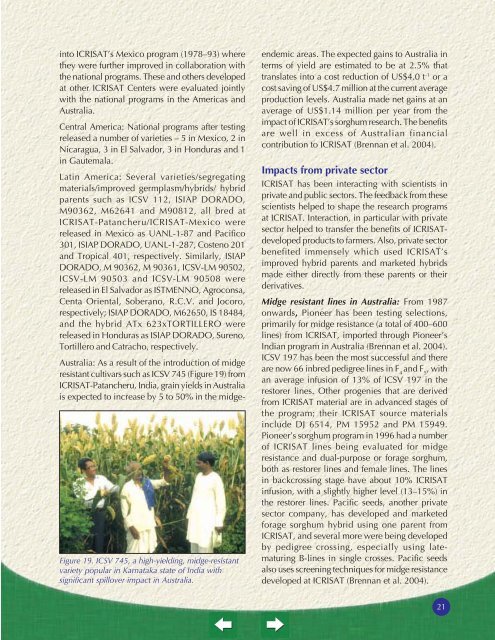Sorghum - icrisat
Sorghum - icrisat
Sorghum - icrisat
Create successful ePaper yourself
Turn your PDF publications into a flip-book with our unique Google optimized e-Paper software.
into ICRISAT’s Mexico program (1978–93) where<br />
they were further improved in collaboration with<br />
the national programs. These and others developed<br />
at other ICRISAT Centers were evaluated jointly<br />
with the national programs in the Americas and<br />
Australia.<br />
Central America: National programs after testing<br />
released a number of varieties – 5 in Mexico, 2 in<br />
Nicaragua, 3 in El Salvador, 3 in Honduras and 1<br />
in Gautemala.<br />
Latin America: Several varieties/segregating<br />
materials/improved germplasm/hybrids/ hybrid<br />
parents such as ICSV 112, ISIAP DORADO,<br />
M90362, M62641 and M90812, all bred at<br />
ICRISAT-Patancheru/ICRISAT-Mexico were<br />
released in Mexico as UANL-1-87 and Pacifico<br />
301, ISIAP DORADO, UANL-1-287, Costeno 201<br />
and Tropical 401, respectively. Similarly, ISIAP<br />
DORADO, M 90362, M 90361, ICSV-LM 90502,<br />
ICSV-LM 90503 and ICSV-LM 90508 were<br />
released in El Salvador as ISTMENNO, Agroconsa,<br />
Centa Oriental, Soberano, R.C.V. and Jocoro,<br />
respectively; ISIAP DORADO, M62650, IS 18484,<br />
and the hybrid ATx 623xTORTILLERO were<br />
released in Honduras as ISIAP DORADO, Sureno,<br />
Tortillero and Catracho, respectively.<br />
Figure 19. ICSV 745, a high-yielding, midge-resistant<br />
variety popular in Karnataka state of India with<br />
significant spillover impact in Australia.<br />
Australia: As a result of the introduction of midge<br />
resistant cultivars such as ICSV 745 (Figure 19) from<br />
ICRISAT-Patancheru, India, grain yields in Australia<br />
is expected to increase by 5 to 50% in the midgeendemic<br />
areas. The expected gains to Australia in<br />
terms of yield are estimated to be at 2.5% that<br />
translates into a cost reduction of US$4.0 t -1 or a<br />
cost saving of US$4.7 million at the current average<br />
production levels. Australia made net gains at an<br />
average of US$1.14 million per year from the<br />
impact of ICRISAT’s sorghum research. The benefits<br />
are well in excess of Australian financial<br />
contribution to ICRISAT (Brennan et al. 2004).<br />
Impacts from private sector<br />
ICRISAT has been interacting with scientists in<br />
private and public sectors. The feedback from these<br />
scientists helped to shape the research programs<br />
at ICRISAT. Interaction, in particular with private<br />
sector helped to transfer the benefits of ICRISATdeveloped<br />
products to farmers. Also, private sector<br />
benefited immensely which used ICRISAT’s<br />
improved hybrid parents and marketed hybrids<br />
made either directly from these parents or their<br />
derivatives.<br />
Midge resistant lines in Australia: From 1987<br />
onwards, Pioneer has been testing selections,<br />
primarily for midge resistance (a total of 400–600<br />
lines) from ICRISAT, imported through Pioneer’s<br />
Indian program in Australia (Brennan et al. 2004).<br />
ICSV 197 has been the most successful and there<br />
are now 66 inbred pedigree lines in F 4<br />
and F 5<br />
, with<br />
an average infusion of 13% of ICSV 197 in the<br />
restorer lines. Other progenies that are derived<br />
from ICRISAT material are in advanced stages of<br />
the program; their ICRISAT source materials<br />
include DJ 6514, PM 15952 and PM 15949.<br />
Pioneer’s sorghum program in 1996 had a number<br />
of ICRISAT lines being evaluated for midge<br />
resistance and dual-purpose or forage sorghum,<br />
both as restorer lines and female lines. The lines<br />
in backcrossing stage have about 10% ICRISAT<br />
infusion, with a slightly higher level (13–15%) in<br />
the restorer lines. Pacific seeds, another private<br />
sector company, has developed and marketed<br />
forage sorghum hybrid using one parent from<br />
ICRISAT, and several more were being developed<br />
by pedigree crossing, especially using latematuring<br />
B-lines in single crosses. Pacific seeds<br />
also uses screening techniques for midge resistance<br />
developed at ICRISAT (Brennan et al. 2004).<br />
21
















